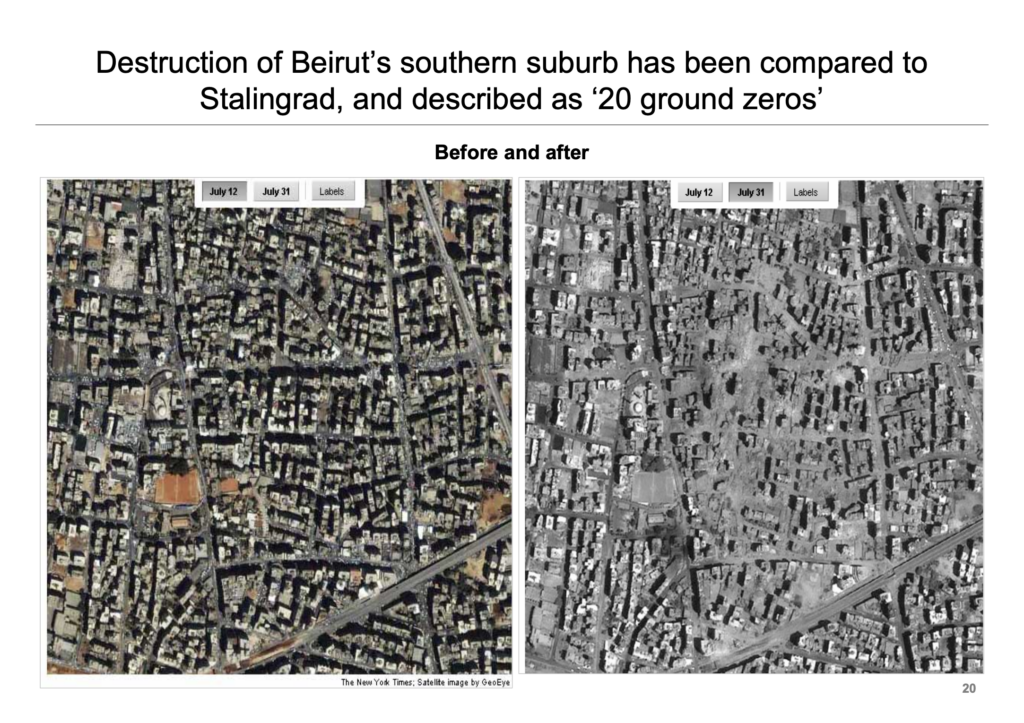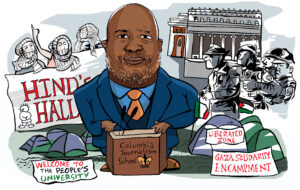
The Gaza Doctrine: Israel’s New Levels of Brutality in Gaza Defines its Warfare in Lebanon

As soon as Israel turned its attention to Lebanon, the news obediently followed suit. All of a sudden, we were back to geopolitics, regional tensions, and “spectacular” Israeli attacks, with little attention given to the cost in human lives. The escalation between Israel and Iran threatens to shift our collective gaze further away from both Lebanon and Gaza. In the meantime, the genocide in Gaza continues, and some of the methods refined there have become cornerstones of Israel’s warfare in Lebanon.
At the start of the war on Gaza, Israel’s massive bombing of civilian areas in Lebanon in 2006—the so-called “Dahiyeh Doctrine“—came to memory. Gadi Eisenkot, Chief of Northern Command in the IDF at the time, explained the doctrine as follows: “We will apply disproportionate force on [each village] and cause great damage and destruction there. From our standpoint, these are not civilian villages, they are military bases.”
The genocide in Gaza has carried a new level of brutality. In what we can call the “Gaza Doctrine,” individuals have now become time bombs that can explode at any moment, regardless of the other human lives they take with them. This has been enabled by the extensive use of databases and intricate intelligence and data systems like “Where’s Daddy?” that tracks individuals and purposely bombs them at night, when they are at home with their families.
The Gaza Doctrine aims at making life unsustainable for entire swathes of the population to put pressure on community support for the political and grassroots organizations that Israel and the West have designated as “terrorist.” To this end, systematic attacks on medical services, coupled with intense bombing, become a tool for collective punishment and mass displacement. When issued, evacuation warnings—which are supposed to warn civilians about an impending strike—are often given at short notice. The designated “safe zones” have consistently proven to be anything but, with Israeli strikes on synthetic refugee tents often setting off fires that extend the scope of damage.
The unpredictability and confusion surrounding these evacuation orders have, however, had one consistent outcome: creating panic and precipitating mass flight. Together, these different facets of the Gaza Doctrine have underlined the dispensability of Palestinian lives and imprinted one truth in the minds of Palestinians in Gaza: nowhere is safe.
Israel’s opening salvo in the recent escalation in Lebanon was an explicit illustration of the Gaza Doctrine. Thousands of pagers imported by Hezbollah exploded simultaneously on September 17, with no regard for where the person carrying them was at the time of the explosion: at the market, the bakery, at work, or at home. What is widely viewed in Lebanon as an indiscriminate terrorist attack, was consistently described by major news outlets as “spectacular.”
The assassination that killed Hassan Nasrallah, the Secretary-General of Hezbollah, follows the same logic on a more destructive scale. By dropping over 80 bombs, many of them weighing close to a ton, on a densely populated residential area, Israel turned everyone in the vicinity into legitimate targets, without this eliciting so much as a raised eyebrow outside the Middle East. The US president, Joe Biden, even called the assassination “a measure of justice for [Nasrallah’s] many victims,” and spokesperson for the US Department of State, Matthew Miller, referred to it as “an unalloyed good.”
There is a qualitative difference between the Dahieh Doctrine and the Gaza Doctrine. While the former targets physical infrastructure, the Gaza Doctrine targets human infrastructure. Hezbollah, like Hamas, is more than just a militant group. It is a grassroots organization that grew as a direct result of the Israeli invasion of Lebanon in 1982. Over the decades, Hezbollah has grown to become a regional actor, as well as a political party with representatives in parliament and a network of schools, hospitals, and welfare services. Although Hezbollah cannot be eradicated, it can be weakened. But this would involve weakening the social foundation that nourishes and supports the party.
Therefore, the targets of Israel’s attacks in Lebanon have been not only Hezbollah militants, but also political, social, and religious members of the party. The Lebanese press consistently reports attacks not only on homes, but also on offices and health services linked to the party. On September 29, over 70 lives were lost in an attack in Ayn al-Dilb near the city of Sidon, where internally displaced families had sought refuge.
Just as in Gaza, attacks in Lebanon have claimed the lives of specific targets, as well as family, friends, and neighbours. A little girl was one of few survivors of an Israeli attack on September 26 in Karak in the Bekaa Valley, where three brothers lived with their mother and their respective families. Among the six killed in a similar attack in Nabi Ayla, also in the Bekaa Valley, was an employee of the UN High Commissioner for Refugees, Dina Darwish, and her young son.
There are many such examples, and the international community has shown a tacit acceptance of what constitutes a legitimate target for Israel in its deliberate escalation in Lebanon. During the 2006 war, one could feel relatively safe if one stayed away from so-called “Hezbollah strongholds.” Under the Gaza Doctrine, potential targets are no longer confined to geographical areas. Israel has extended the range of targets in the latest attacks in Lebanon to new areas, both Sunni Muslim and Christian.
The systematic targeting of health and rescue services has destabilized the fabric of the communities around them and render life impossible under the pressure of bombardment. In a country like Lebanon, this psychological warfare creates tensions between Muslim Shia and other communities. It also attempts to make it difficult to be Shia in the country today, in a collective punishment for making the “wrong” political choices.
To separate what is happening in Gaza from Israel’s war in Lebanon is to uncritically follow the Israeli narrative. Both fronts constitute a war where the killing of civilians is not an unfortunate consequence of the war, but constitutes the war itself, to borrow Howard Zinn’s reflection on the Vietnam War. In the first two weeks alone since the pager attack in Lebanon, Israeli attacks claimed over a thousand lives, including 104 children and 194 women.
The Gaza Doctrine in Lebanon has forced at least one million—a fifth of the population—to flee their homes. According to the Office of the UN High Commissioner for Human Rights, a quarter of Lebanese territory is now under Israeli military displacement orders. Western politicians refer to this as a “dangerous escalation,” with no thought for or mention of the toll this has on Lebanese lives and livelihoods, while Israel continues its human rights violations in Palestine without facing any consequences.
Again, a new generation of Arabs has received the following message: your lives are worth less.
Without justice for Palestinians, there will never be peace in the Middle East, only anger and frustration. History has shown that every attempt to stifle a political movement that captures this anger and frustration only breeds more and worse violence.
This is a revised version of an op-ed originally published in Norwegian in Klassekampen (October 4, 2024).





